Welcome to the ultimate guide to Death Valley, where extreme weather conditions create a captivating wilderness unlike any other. In this section, I’ll provide you with all the information you need to plan your trip to Death Valley, including weather forecasts, safety guidelines, and an overview of the national park’s top attractions and activities.
Key Takeaways:
- Death Valley experiences extreme weather conditions
- Temperatures can exceed 100°F (38°C) in summer and drop to around 50°F (10°C) in winter
- Spring and fall are the best times to visit for milder weather
- Key attractions include Badwater Basin, Dante’s View, Zabriskie Point, Artist’s Palette, and Mesquite Flat Sand Dunes
- Activities range from hiking and scenic drives to stargazing and wildlife watching
Weather in Death Valley

When planning a trip to Death Valley, it is essential to understand the unique weather conditions that await you. Death Valley is known for its extreme climate, characterized by scorching temperatures and arid conditions. The average temperature in Death Valley can exceed 100°F (38°C) during the summer months and drop to around 50°F (10°C) in the winter.
The hot and dry climate makes Death Valley one of the hottest places on Earth. It is important to be prepared for the extreme heat and take necessary precautions to ensure your safety. This includes wearing lightweight, breathable clothing, applying sunscreen with a high SPF, and staying hydrated by drinking plenty of water.
During your visit, it is crucial to be aware of the daily weather forecast and plan your activities accordingly. The scorching temperatures in Death Valley can be unforgiving, especially during the peak summer months. It is advisable to avoid outdoor activities during the hottest parts of the day and seek shade or air-conditioned areas when necessary.
| Month | Average Temperature (°F) |
|---|---|
| January | 65 |
| February | 72 |
| March | 82 |
| April | 91 |
| May | 100 |
| June | 110 |
| July | 116 |
| August | 114 |
| September | 106 |
| October | 94 |
| November | 77 |
| December | 65 |
Despite the extreme temperatures, Death Valley’s weather can still offer unique experiences and stunning landscapes. From colorful sunsets to clear night skies perfect for stargazing, the weather in Death Valley adds to the park’s allure. It is important to come prepared, stay informed about the weather conditions, and make the most of your visit to this remarkable destination.
Key Attractions in Death Valley
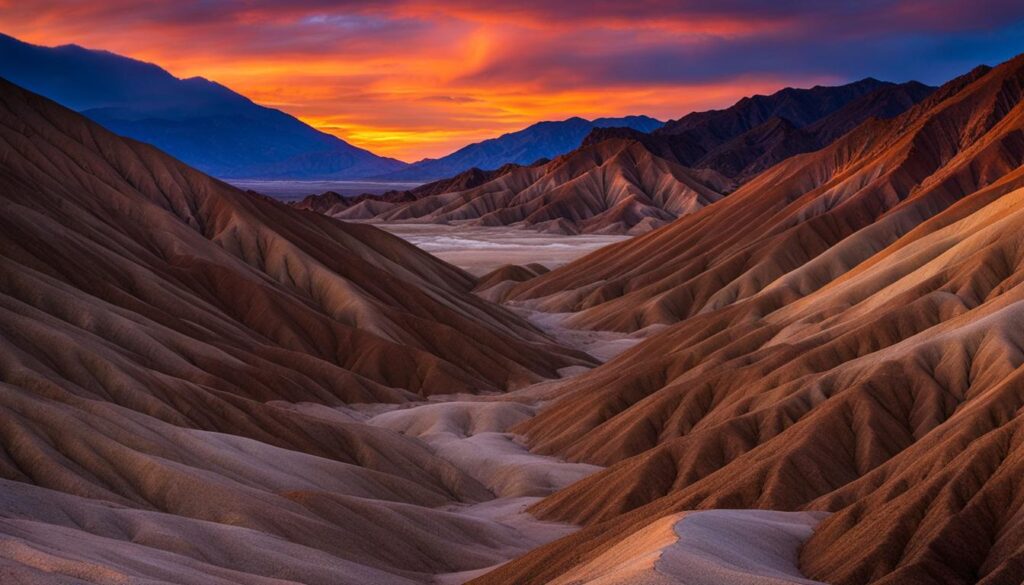
When visiting Death Valley, there are several key attractions that you won’t want to miss. These iconic destinations offer unique experiences and breathtaking views of the park. From the lowest point in North America to stunning geological formations, there is something for everyone to enjoy.
Badwater Basin
One of the most famous attractions in Death Valley is Badwater Basin, located at an elevation of 282 feet below sea level. It is the lowest point in North America and offers a surreal landscape of salt flats that stretch for miles. Visitors can walk out onto the salt flats and marvel at the otherworldly scenery.
Dante’s View
For panoramic views of Death Valley, make sure to visit Dante’s View. Perched at an elevation of 5,475 feet, this vantage point provides stunning vistas of the valley below. You can see the vast expanse of Death Valley, surrounded by majestic mountains. It is especially breathtaking during sunrise or sunset.
Zabriskie Point
Zabriskie Point is another popular attraction in Death Valley, known for its vibrant and colorful rock formations. The eroded landscape creates a stunning display of various hues, making it a photographer’s dream. The viewpoint offers a fantastic perspective of the unique geological features that have been shaped by millions of years of erosion.
Artist’s Palette
Located in the Black Mountains, Artist’s Palette is a colorful and picturesque area of Death Valley. The hillsides are adorned with a vibrant array of minerals, including hues of pink, purple, green, and yellow. The contrasting colors create a captivating spectacle that is a feast for the eyes.
Mesquite Flat Sand Dunes
The Mesquite Flat Sand Dunes are a must-visit for those seeking a unique desert experience. These massive dunes create an otherworldly landscape and offer an excellent opportunity for photography and exploration. Walking along the sandy crests of the dunes provides a sense of serenity amidst the vastness of Death Valley.
| Attraction | Location | Highlights |
|---|---|---|
| Badwater Basin | Located in the southern part of Death Valley | Lowest point in North America, salt flats |
| Dante’s View | Located in the Black Mountains | Panoramic views of Death Valley |
| Zabriskie Point | Located east of Furnace Creek | Colorful rock formations, stunning vistas |
| Artist’s Palette | Located in the Black Mountains | Vibrant mineral hues, unique geological features |
| Mesquite Flat Sand Dunes | Located near Stovepipe Wells | Massive sand dunes, desert landscape |
Activities and Things to Do in Death Valley
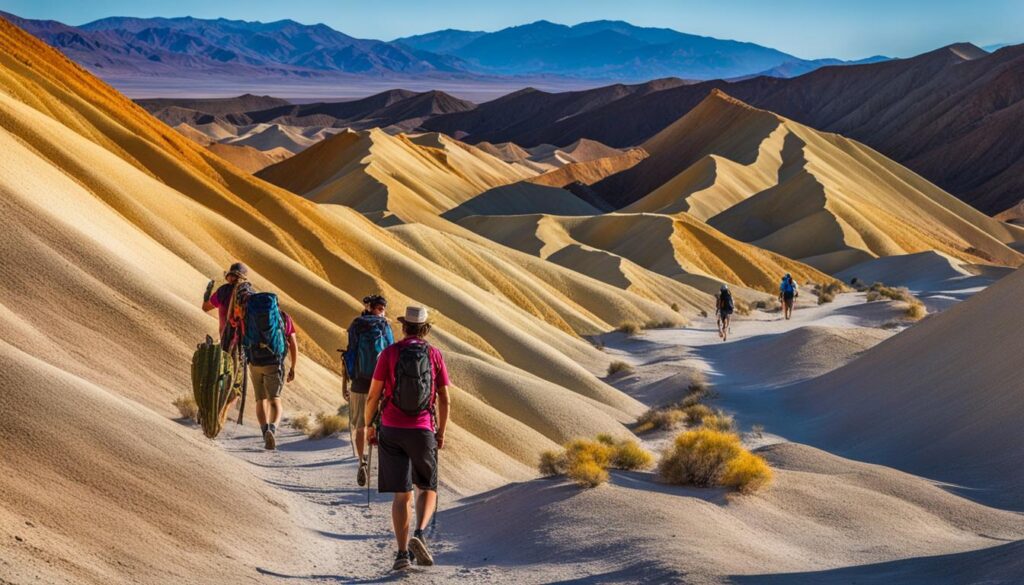
When visiting Death Valley, there are numerous activities and things to do that cater to a variety of interests. Whether you are a nature enthusiast, history buff, or simply enjoy outdoor adventures, the park offers something for everyone.
1. Hiking and Exploration: Death Valley is home to a diverse range of landscapes, making it a haven for hikers. The Golden Canyon trails provide stunning views of the park’s unique rock formations, while the Mesquite Flat Sand Dunes offer a chance to experience the vastness of the desert. Don’t miss the opportunity to explore historic sites like the Harmony Borax Works and the ghost town of Rhyolite.
2. Scenic Drives: Take a leisurely drive along Badwater Road, which allows you to experience the park’s breathtaking scenery. The road passes by iconic landmarks such as Badwater Basin, the lowest point in North America, and Artist’s Palette, known for its vibrant color formations. Enjoy the serenity of the park as you drive through stunning landscapes.
3. Stargazing: Death Valley is renowned for its dark skies and exceptional stargazing opportunities. Head to the Mesquite Flat Sand Dunes or Dante’s View for unobstructed views of the night sky. Don’t forget to bring a telescope or binoculars to fully appreciate the wonders of the cosmos.
“Death Valley offers a wide range of activities and experiences for visitors, from hiking through unique landscapes to stargazing under the dark desert skies. There is no shortage of adventure and exploration in this captivating national park.”
4. Wildlife Watching: Death Valley is teeming with fascinating wildlife. Keep an eye out for desert bighorn sheep, coyotes, and various bird species as you explore the park. Remember to observe animals from a safe distance and respect their natural habitat.
These are just a few examples of the activities and things to do in Death Valley. Whether you prefer to embark on an epic hike, go on a scenic drive, or simply soak in the beauty of the desert, the park offers endless opportunities for adventure and discovery.
Best Times to Visit Death Valley
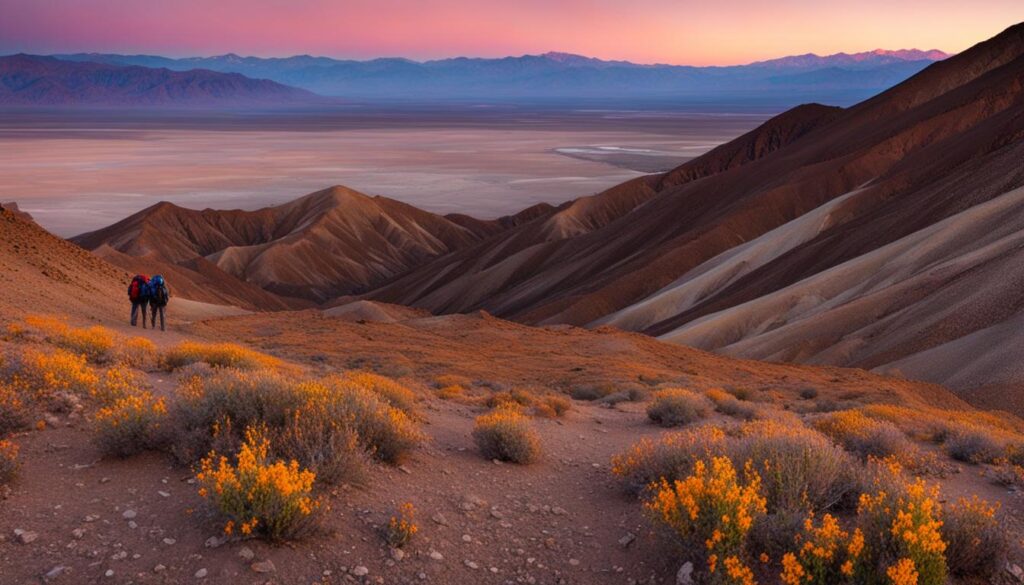
If you’re planning a visit to Death Valley, it’s important to choose the best time to ensure an enjoyable experience. The extreme weather conditions in the park make certain seasons more favorable for exploring. The best time to visit Death Valley is during the spring and fall months when the temperatures are more moderate.
In the spring, from March to May, the weather starts to warm up, and you can witness the desert wildflowers in full bloom. This is a beautiful time to visit, with temperatures ranging from 70°F to 90°F (21°C to 32°C). The fall season, from October to November, offers similar weather conditions, making it another ideal time to explore the park. These months typically have temperatures ranging from 75°F to 95°F (24°C to 35°C).
It’s important to avoid visiting Death Valley during the summer months when temperatures can be dangerously hot, often exceeding 100°F (38°C). The scorching heat can make outdoor activities challenging and even hazardous. Additionally, the park tends to be more crowded during the summer, which can diminish the overall experience.
By planning your visit during the spring or fall, you can enjoy milder temperatures, vibrant landscapes, and a more peaceful atmosphere. Keep in mind that weather conditions can vary, so it’s always a good idea to check the forecast and be prepared with appropriate clothing, sunscreen, and plenty of water.
Table: Average Temperatures in Death Valley
| Month | High Temperature (°F) | Low Temperature (°F) |
|---|---|---|
| January | 66 | 39 |
| February | 72 | 45 |
| March | 80 | 52 |
| April | 90 | 61 |
| May | 100 | 70 |
| June | 110 | 80 |
| July | 120 | 88 |
| August | 116 | 85 |
| September | 107 | 75 |
| October | 93 | 63 |
| November | 77 | 48 |
| December | 65 | 39 |
Hours and Operations in Death Valley
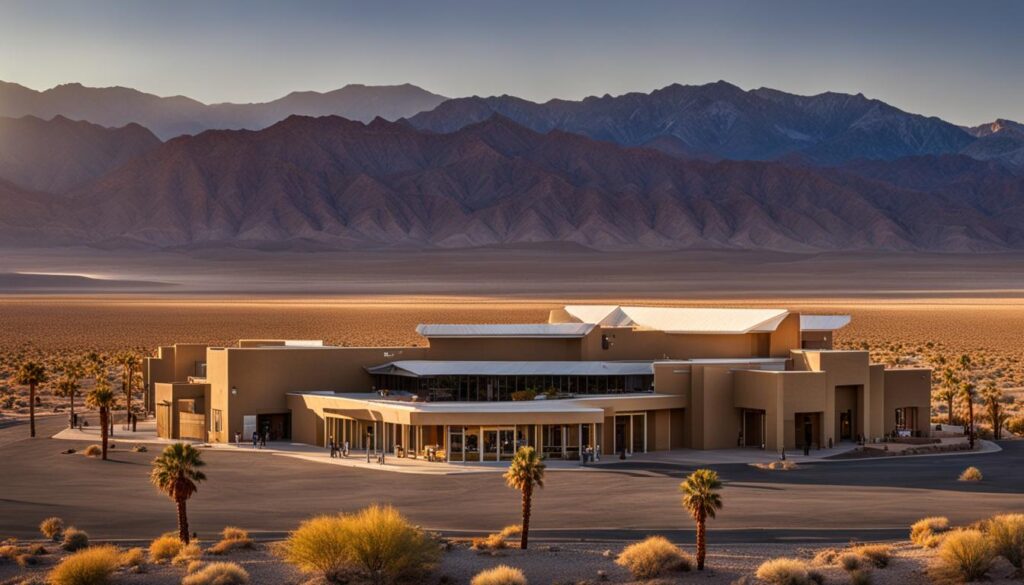
When planning your visit to Death Valley, it is important to be aware of the park’s operating hours and visitor center information. The park has designated hours of operation for various facilities and attractions, which can vary depending on the time of year. The visitor centers in Death Valley serve as valuable resources for visitors, providing information on current conditions, closures, and safety guidelines.
One of the main visitor centers in Death Valley is the Furnace Creek Visitor Center, located near the center of the park. It offers exhibits, maps, and knowledgeable staff who can provide guidance and answer any questions you may have about your visit. The Furnace Creek Visitor Center is typically open daily from 8:00 am to 5:00 pm, but it is important to check the park’s website for the most up-to-date hours of operation.
In addition to the Furnace Creek Visitor Center, there are other visitor centers and ranger stations throughout the park that offer information and assistance. These include the Stovepipe Wells Ranger Station, the Scotty’s Castle Visitor Center (currently closed due to flood damage), and the Panamint Springs Ranger Station. Each visitor center has its own operating hours, so it is recommended to check the park’s website or contact the visitor center directly for specific information.
By familiarizing yourself with the hours and operations in Death Valley, you can ensure that you make the most of your visit and have access to the resources and information needed for a safe and enjoyable experience.
RV Parks and Camping in Death Valley

When visiting Death Valley, there are various options for accommodation, including RV parks and camping sites. These options allow visitors to immerse themselves in the natural beauty of the park and enjoy a unique camping experience. Whether you prefer RV camping or tent camping, Death Valley offers several campgrounds with basic amenities and facilities for a comfortable stay.
If you’re planning to bring your RV, there are designated RV parks within Death Valley National Park. These parks provide convenient access to the park’s attractions and ensure a memorable camping experience. It’s important to make reservations in advance, especially during peak seasons, as availability can be limited. The RV parks in Death Valley often offer amenities such as hookups for water and electricity, dump stations, and restroom facilities.
For those who prefer tent camping, there are also campgrounds available throughout the park. These campgrounds offer scenic views and a more rustic camping experience. Campers can enjoy the tranquility of the desert environment while being surrounded by breathtaking landscapes. It’s advisable to check the official Death Valley National Park website for information on campground availability, restrictions, and any special guidelines.
Table: Comparison of RV Parks and Campgrounds in Death Valley
| RV Parks | Campgrounds |
|---|---|
| Located within the national park | Scattered throughout the park |
| Offer amenities such as water and electricity hookups | Basic facilities with no hookups |
| Dump stations available | No dump stations |
| Restroom facilities provided | Restroom facilities available |
| Reservations recommended | Reservations recommended |
Whether you choose RV camping or tent camping in Death Valley, it’s important to come prepared. Make sure to pack essential camping gear, including a tent, sleeping bags, cooking equipment, and sufficient food and water. It’s also crucial to familiarize yourself with the park’s camping regulations and safety guidelines to ensure a safe and enjoyable experience. By immersing yourself in the stunning landscapes and unique atmosphere of Death Valley, you’re sure to create unforgettable memories.
Hotels, Campsites, and Cabins in Death Valley
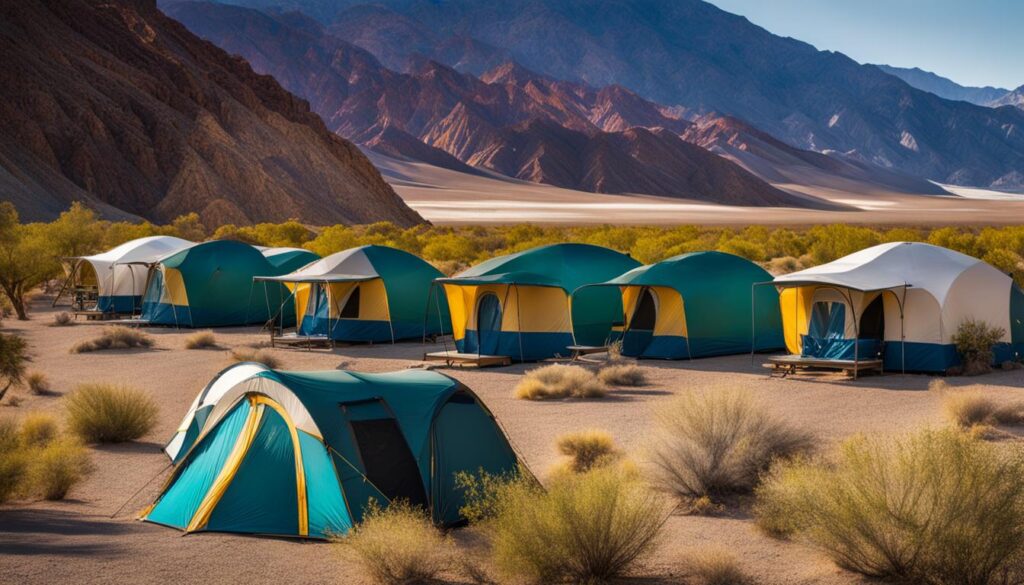
When visiting Death Valley, there are various options for accommodations to suit different preferences and needs. Whether you prefer the comfort of a hotel, the rustic charm of a campsite, or the coziness of a cabin, there are choices available both within the park and in nearby towns.
Hotels
If you’re seeking modern amenities and convenience, staying at a hotel in or around Death Valley might be the right choice for you. There are several hotels offering comfortable rooms, on-site dining options, and recreational facilities. Some popular hotels near Death Valley National Park include:
- The Oasis at Death Valley
- The Inn at Death Valley
- Stovepipe Wells Village Hotel
- Panamint Springs Resort
Campsites
For those who love to immerse themselves in nature, camping in Death Valley is a fantastic option. There are several campgrounds within the park that provide basic amenities and the opportunity to experience the beauty of the desert night sky. Some notable campsites include:
- Furnace Creek Campground
- Texas Springs Campground
- Mesquite Spring Campground
- Emigrant Campground
Cabins
If you’re looking for a cozy retreat after a day of exploring, cabins in Death Valley offer a unique experience. There are cabins available within the park that provide a comfortable and secluded setting, allowing you to unwind and enjoy the tranquility of the desert. Some cabins to consider are:
- The Ranch at Death Valley
- Panamint Springs Resort Cabins
- Stovepipe Wells Village Cabins
It’s important to note that Death Valley can experience high demand, especially during peak tourist seasons. It’s recommended to make reservations for hotels, campsites, and cabins well in advance to secure your preferred choice and dates.
Planning Your Visit to Death Valley

When planning your trip to Death Valley, it is important to take into consideration various factors to ensure a successful and enjoyable visit. From directions to parking tips and safety guidelines, here are some essential travel tips and visitor information to help you make the most of your time in this unique national park.
Directions and Parking
Death Valley is located in California and can be accessed by car via major highways such as US Route 395 and California State Route 190. It is important to plan your route in advance and check for any road closures or construction updates. Once you arrive at the park, there are several parking areas available near popular attractions and trailheads. It is recommended to arrive early, especially during peak seasons, to secure a parking spot.
Safety Tips
Due to its extreme weather conditions, it is crucial to prioritize safety during your visit to Death Valley. Be sure to pack plenty of water and stay hydrated, as the desert heat can be intense. Additionally, wearing sunscreen, a hat, and light-colored, breathable clothing will help protect you from the sun. It is also advisable to hike during cooler hours, bring a map and compass, and inform someone about your itinerary if you plan on exploring remote areas.
Visitor Information
Before your trip, it is highly recommended to visit the official Death Valley National Park website for the most up-to-date information on park closures, weather conditions, and safety alerts. The website provides valuable resources, including maps, brochures, and information on guided tours and ranger programs. Familiarizing yourself with the park’s rules and regulations will ensure a respectful and responsible visit to this stunning natural wonder.
Table: Death Valley Visitor Information
| Visitor Centers | Contact Information | Operating Hours |
|---|---|---|
| Furnace Creek Visitor Center | Phone: (760) 786-3200 | Open daily from 8:00 AM to 5:00 PM |
| Stovepipe Wells Ranger Station | Phone: (760) 786-3200 | Open daily from 8:00 AM to 4:30 PM |
| Scotty’s Castle Visitor Center | Phone: (760) 786-3200 | Temporarily closed due to flood damage |
By planning your visit to Death Valley in advance and staying informed about the park’s guidelines and conditions, you can have a safe and enjoyable experience exploring the stunning landscapes and unique attractions this national park has to offer.
Conclusion
In conclusion, a trip to Death Valley National Park is an extraordinary experience for nature enthusiasts and adventure seekers. With its unique weather conditions, breathtaking landscapes, and diverse attractions, Death Valley offers something for everyone. By following the provided tips and guidelines, you can ensure a successful and memorable trip to this remarkable national park.
During your visit to Death Valley, it is important to stay hydrated and mindful of the weather. The extreme temperatures can pose risks, especially during the summer months, so it is crucial to take proper sun protection and hydration measures. Additionally, respecting the park’s rules and regulations ensures the preservation of this natural wonder for future generations.
As you plan your Death Valley trip, remember to consider the best times to visit, the key attractions, and the various activities available. Whether you choose to hike through the unique landscapes, explore historic sites, or simply take in the stunning views, there is no shortage of things to see and do in Death Valley National Park.
So, pack your bags, prepare for an adventure, and embark on a journey to Death Valley. This national park guide has provided essential information and tips to help you make the most of your trip. Enjoy the beauty and wonder of Death Valley as you create unforgettable memories in this extraordinary destination.
FAQ
What is the climate like in Death Valley?
Death Valley has a hot and dry climate, with scorching temperatures during the summer months. The average temperature can exceed 100°F (38°C) in the summer and can drop to around 50°F (10°C) in the winter.
What are some key attractions in Death Valley?
Some key attractions in Death Valley include Badwater Basin, the lowest point in North America, Dante’s View, Zabriskie Point, Artist’s Palette, and Mesquite Flat Sand Dunes.
What activities can I do in Death Valley?
In Death Valley, you can hike through unique landscapes, explore historic sites, go stargazing, and watch wildlife. Popular activities include hiking the Golden Canyon trails, taking a scenic drive along Badwater Road, and visiting the historic Scotty’s Castle.
When is the best time to visit Death Valley?
The best time to visit Death Valley is during the spring and fall seasons when the temperatures are more moderate. The months of March to May and October to November offer milder weather and are ideal for outdoor activities. It is important to avoid visiting during the summer months when the temperatures can be dangerously hot.
What are the operating hours and visitor center information in Death Valley?
The park’s visitor centers provide valuable resources and information about current conditions, closures, and safety guidelines. It is recommended to check the park’s website for the most up-to-date information on hours and operations.
Are there RV parks and camping options in Death Valley?
Yes, there are several campgrounds within the park that provide basic amenities and facilities for both tent camping and RVs. It is important to make reservations in advance, especially during peak seasons, and to be aware of any restrictions or guidelines for camping in the park.
What are the accommodation options in Death Valley?
Death Valley offers options for accommodations such as hotels, campsites, and cabins. There are several options available both within the park and in nearby towns. It is recommended to book accommodations in advance, especially during the peak tourist season.
How should I plan my visit to Death Valley?
Planning your visit to Death Valley requires careful consideration of various factors. It is important to be prepared and knowledgeable about the park’s rules and regulations. This section will provide essential information on directions, parking, safety tips, and other important details to help you plan a successful trip.

